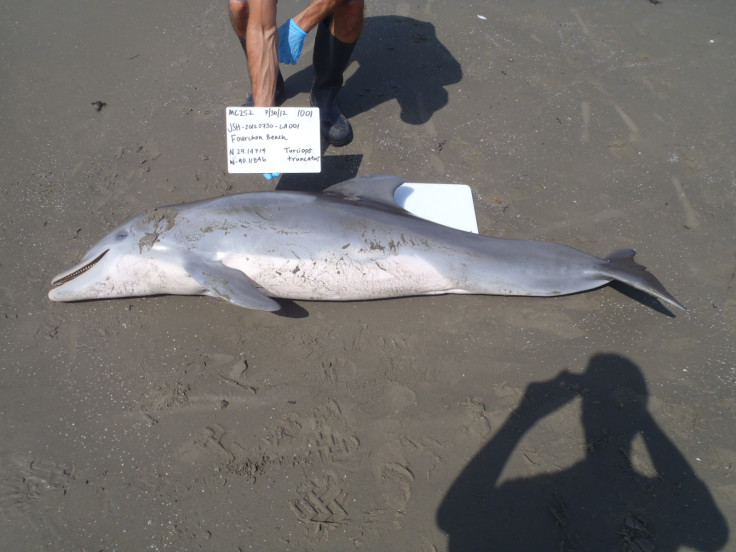Dolphin deaths tied to Deepwater oil spill in tissue sample study

Bottlenose dolphins stranded in the northern Gulf of Mexico following the Deepwater Horizon oil spill, died from rare lesions associated with petroleum exposure, according to a study by the National Oceanic and Atmospheric Administration (Noaa).
The scientists compared tissue samples from 46 dolphins in areas affected by the spill with 106 dolphins that were not exposed.
One-third of the oil-exposed dolphins suffered rare adrenal damage rendering them incapable of producing some critical hormones, consistent with petroleum exposure, the study found. Only 7% of the dolphins found away from the spill had similar adrenal disease.
The adrenal gland produces hormones – such as cortisol and aldosterone – that regulate metabolism, blood pressure and other bodily functions.
The 2010 oil spill caused by an explosion aboard BP's Deepwater Horizon oil rig saw millions of barrels of crude oil flow into the Gulf of Mexico waters. A dolphin die-off around coastal Louisiana, Alabama and Mississippi was among the casualties borne by marine life in the region.
"This is the latest in a series of peer-reviewed scientific studies, conducted over the five years since the spill, looking at possible reasons for the historically high number of dolphin deaths that have occurred within the footprint of the Deepwater Horizon spill," said Dr Teri Rowles, veterinarian and one of 22 contributing authors on the paper.
These findings support those of a 2011 health assessment of live dolphins in Barataria Bay, Louisiana, which was affected by the spill and showed those resident dolphins had poor health, adrenal disease, and lung disease.
Since early 2010, there has been an ongoing cetacean unusual mortality event involving primarily bottlenose dolphins in the northern Gulf of Mexico.
Three out of four groupings of elevated dolphin strandings identified within this event followed the Deepwater Horizon oil spill.
This ongoing die-off coincided with the largest marine-based oil spill in the United States.
The dead dolphins from Barataria Bay had a thin adrenal gland cortex, indicative of adrenal insufficiency. One in every three dolphins examined across Louisiana, Mississippi and Alabama had this lesion.
In addition to the adrenal lesions, it was seen that more than one in five dolphins that died had a severe primary bacterial pneumonia that led to death.
"These dolphins had some of the most severe lung lesions I have seen in the over 13 years that I have been examining dead dolphin tissues from throughout the United States," said Dr. Kathleen Colegrove, the study's lead veterinary pathologist based at the University of Illinois.
In comparison, only 2% of reference dolphins had these lesions.
Update:
Meanwhile, Geoff Morrell, BP's senior vice president of US communications and external affairs told IBTimes UK: "The data we have seen thus far, including the new study from NOAA, do not show that oil from the Deepwater Horizon accident caused an increase in dolphin mortality."
"This new paper fails to show that the illnesses observed in some dolphins were caused by exposure to Macondo oil. In fact, numerous studies conducted over the last several decades have shown that respiratory illness – one of the conditions cited – is among the most common causes of death for bottlenose dolphins, including a study where half of the dolphins examined had pneumonia [A 30-year retrospective evaluation of pneumonia in a bottlenose dolphin Tursiops truncatus population, published in Journal of Diseases of Aquatic Organisms]."
"Based on a review of available literature, we are unaware of any toxicological studies linking lung disease in bottlenose dolphins to exposure to oil or other environmental contaminants," Morrell added.
According to NOAA, the Gulf unusual mortality event (UME) began in February 2010, months before the spill. Even though the UME may have overlapped in some areas with the oil spill, correlation is not evidence of causation.
"Importantly, oil was not identified as the cause of death in any of the 130 dolphin necropsies (animal autopsies) conducted by the government's own veterinarians. Also, despite Freedom of Information Act Requests, NOAA has refused to publicly release hundreds of additional dolphin necropsy reports. Just a small sample set of the dolphins (46) were used for this study," claimed BP's senior VP.
Dolphins are particularly susceptible to inhalation effects of petroleum-based polycyclic aromatic hydrocarbons (PAH) due to their large lungs, deep breaths and extended breath hold times.
The findings have been published in the online journal PLOS ONE.

© Copyright IBTimes 2025. All rights reserved.





















